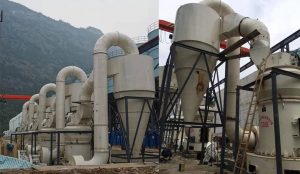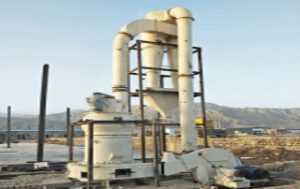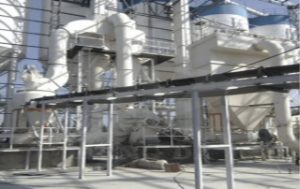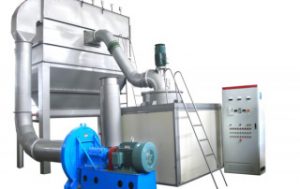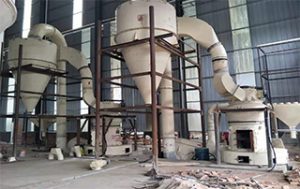What is gypsum
Gypsum is a monoclinic mineral and a hydrate mainly composed of calcium sulfate (CaSO4). Gypsum is a widely used industrial and building material. It can be used for cement retarder, gypsum building products, model making, medical food additives, sulfuric acid production, paper filler, paint filler, etc.
The microporous structure and heating dehydration of gypsum and its products make it have excellent sound insulation, heat insulation and fire resistance.
Medical applications (not expanded)
Food industry application
According to the hygienic standard for the use of food additives in China, gypsum is used as a coagulant in the production of canned and bean products, and the dosage is added according to the needs of normal production. It is used to make tofu. The addition amount of soybean milk is 2 ~ 14g / L. excessive will produce bitter taste, that is, gypsum is about 2.25% of the raw material in summer and 4.1% of the raw material in winter. When used to make dried tofu, the amount of gypsum used is about 2% of the raw material in summer and 4.3% in winter. In the production of canned tomatoes and potatoes, calcium sulfate can be used as tissue enhancer, adding 0.1% ~ 0.3% according to the production formula.
According to the regulations of FAO / who 1984, it is used as coagulant in canned tomatoes. The dosage is: tablet package, 0.8g/kg; Packaged, 0.45g/kg (used alone or in combination with other coagulants) [6].
Industrial application
Gypsum belongs to monoclinic system, with high cleavage and easy to crack into thin sheets. When gypsum is heated to 100 ~ 200 ° C and some crystal water is lost, hemihydrate gypsum can be obtained. It is a kind of pneumatic cementitious material with α And β Both forms are rhombic crystals, but their physical properties are different. α Type hemihydrate gypsum has good and solid crystallization; β Type a hemihydrate gypsum is a flake crystal with cracks. The crystal is very fine and the specific surface area ratio is α Type hemihydrate gypsum is much larger.
When producing gypsum products, α Type hemihydrate gypsum ratio β The product has high compactness and strength. It is usually made by steaming in saturated steam medium in autoclave α Type hemihydrate gypsum, also known as high strength gypsum; It is calcined with an open device in a frying pan or rotary kiln β Type hemihydrate gypsum, i.e. building gypsum. Chemical gypsum, an industrial by-product, has the same properties as natural gypsum and does not need too much processing. The slurry mixed with hemihydrate gypsum and water re forms dihydrate gypsum, which quickly condenses and hardens in the drying process to obtain strength, but softens in case of water.
Gypsum is the main raw material for the production of gypsum cementitious materials and gypsum building products, and it is also the retarder of Portland cement. Anhydrite cement (also known as Kim’s cement) can be obtained by calcining gypsum at 600 ~ 800 ° C and grinding it together with a small amount of lime and other catalysts; High temperature calcined gypsum can be obtained by calcining and grinding at 900 ~ 1000 ° C. The products made of these two kinds of gypsum have higher strength than building gypsum products, and anhydrite binder has better heat insulation, and high-temperature calcined gypsum has better wear resistance and water resistance.
The building products produced by gypsum board using building gypsum mainly include:
① Paper faced gypsum board. A small amount of adhesive, fiber, foam agent and so on were added to the gypsum, and then poured continuously between two layers of tissue paper and then rolled, solidified, cut and dried. The plate thickness is 9 ~ 25mm, and the dry unit weight is 750 ~ 850 kg / m3. The plate has good toughness, nonflammable, stable size and flat surface. It can be sawed for construction. It is mainly used for internal partition wall, internal wall veneer, ceiling, sound-absorbing board, etc., but it has poor water resistance and is not suitable for wet environment.
② Fiber gypsum board. The construction gypsum slurry mixed with fiber and other additives is formed by winding, pressure filtration or rolling, and then cut, solidified and dried. The thickness is generally 8 ~ 12mm. Compared with the paper gypsum board, it has higher bending strength. There is no face protection paper and adhesive, but the bulk density is large, and the purpose is the same as that of the paper gypsum board.
③ Decorative gypsum board. The prepared building gypsum slurry is poured into the mold frame with pattern on the bottom mold, which is troweled, solidified, demoulded and dried. The thickness of the board is about 10mm. In order to improve its sound absorption effect, it can also be made into plates with perforations and blind holes, which are often used as ceilings and decorative walls.
④ Gypsum hollow strips and gypsum blocks. The building gypsum slurry is poured into the mold, demoulded and dried after vibration molding and solidification. The thickness of hollow strip is generally 60 ~ 100mm, and the hole rate is 30 ~ 40%; The block size is generally 600 × 600 mm, 60 ~ 100 mm thick, with tongue and groove around it. Sometimes it can also be made into hollow blocks with round holes. Hollow slats and blocks are built with special gypsum, which is convenient for construction and commonly used as non load-bearing internal partition wall.
industrial production
Gypsum ore
According to the data from the USGS “mineral Yearbook”, 106 million tons of natural gypsum were mined and consumed worldwide in 2004. The United States has the largest mining volume, reaching 18 million tons, accounting for 17% of the global mining volume; Then followed by Iran (10.8%), Canada (8.5%), Spain (7.1%), China (6.5%, i.e. 6.9 million tons) (but according to the statistics of relevant Chinese departments, 29 million tons are mainly used for cement production). Other top 10 countries include Thailand, Australia, France and Germany, which together account for 72% of the world’s mining volume.
According to the data of onestone consulting company in Germany, about 45% of the global natural gypsum mining volume is processed into mature gypsum. The annual output of gypsum in the world is about 66.5 million tons, of which 60% or 40 million tons are from natural gypsum and 40% or 26.5 million tons are from synthetic gypsum and recycled waste gypsum. It is estimated that the annual output of synthetic gypsum in the world is about 160 million tons, of which about 35 million tons come from desulfurization gypsum produced by desulfurization system of power station, about 11 million tons are phosphogypsum by-product of phosphate fertilizer production, and about 15 million tons are titanium gypsum and other chemical gypsum. 90% of synthetic gypsum used in gypsum industry comes from desulfurization gypsum.
For the gypsum industry, about 80% of hydrated gypsum is used to produce building wallboards. About 20% is used to produce gypsum plaster or other gypsum products.
For gypsum board factories, it is important for gypsum to have a short setting time. Flash firing, grinding and calcination co production processes are usually used. For the use of desulfurization gypsum, the calciner and related supporting hammer mills are designed by each plant according to its own process. The grinding and calcination system and its matching vertical roller mill account for about 40% of the market share. The market leader is Claudius Peters process, who has received orders for 9 EM pulverizer systems in the past two years. The MPS gypsum mill of gebr.pfeiffer Ag can actually meet any production requirements and allows up to 45% desulfurization gypsum to be added during calcination.
The gypsum board factory is dried by a downstream dryer or a countercurrent dryer. For the drying of fiber gypsum board, it is dried by dry screening machine. The dryers for gypsum board with the smallest space shall have a retention time of 32 ~ 40 minutes. Each group is designed with 6 ~ 16 board surfaces and 3 drying areas. The accuracy of the feeding device of the downstream dryer is very important. Firstly, the plates are cut and arranged on a series of plate surfaces, and then stacking is started; The following board must maintain the principle of “in and out” and maintain stable quality.
Machine operation in gypsum board factory is becoming more and more important. This involves the coordination of wet end equipment, dry feeding equipment and destacking equipment, as well as the coordination of dry end equipment and stacking equipment. These equipment must be able to operate flexibly to produce gypsum boards of different sizes, thickness and quality. When producing different products, the manual operation must meet the safety requirements. Although the transformation of mechanized production methods in modern chemical plants can almost ensure raw meal preparation and paper manipulation, the operation of the board is fully automated. However, the high production rate also requires a perfect palletizing system at the end of production.
Gypsum grinding process flow
Stage I: crushing
Large gypsum materials are crushed by the crusher to the feed fineness (less than 30mm) that can enter the pulverizer.
Stage 2: material grinding
The crushed gypsum small materials are sent to the raw material bin by the elevator, and then sent to the grinding chamber of the mill evenly and quantitatively by the vibrating feeder for grinding. After grinding, the milled materials are graded by the analyzer. Those whose fineness meets the specification flow into the large cyclone collector with the wind, and then discharged into finished products through the discharge valve. Those whose fineness is unqualified cannot be screened by the analyzer, but still fall back to the host for re grinding.
Stage III: storage or packaging of finished products in cans
① The finished products discharged from the discharge valve are transported to the finished product tank for storage by pneumatic conveying equipment.
② The finished products discharged from the discharge valve are packaged by a double mouth packaging machine.
③ The finished products discharged from the discharge valve are packaged by the ton baler.


